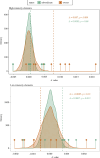Receiver response to high-intensity courtship differs with courter status in spotted bowerbirds Ptilonorhynchus maculatus
- PMID: 39445089
- PMCID: PMC11495961
- DOI: 10.1098/rsos.232015
Receiver response to high-intensity courtship differs with courter status in spotted bowerbirds Ptilonorhynchus maculatus
Abstract
Understanding sexual communication requires assessing the behaviour of both the sender and the receiver. Receiver responses to sexual displays carry relevant information, but such signals or cues may be subtle and therefore technically challenging to investigate. Here, we focus on receiver body movements in response to high-intensity courtship in spotted bowerbirds (Ptilonorhynchus maculatus). Male bowerbirds perform a vigorous courtship choreography on dedicated display structures-bowers. Bower owners tolerate other non-territorial males at their bowers, yet the courtship displays of these so-called 'subordinate' males rarely result in successful copulations. Males that display at high intensity are preferred by females in this species, yet excessively aggressive displays may be threatening, hence scaring prospective mates away. In this study, we hypothesized that bower owners are better able to exhibit high-intensity movements without startling their audience compared with subordinate males. To address this question, we used a combination of behavioural coding and AI-based tracking of body movements, which allows precise spatial and temporal resolution for the study of subtle behavioural responses. Contrary to our predictions, we found that bower owners evoked stronger startle responses than subordinate males. We discuss these unexpected results and suggest further experimental approaches for future investigations.
Keywords: courtship; machine learning; signal receiver; startle response; visual display.
© 2024 The Author(s).
Conflict of interest statement
We declare we have no competing interests.
Figures




Similar articles
-
Male-male associations in spotted bowerbirds (Ptilonorhynchus maculatus) exhibit attributes of courtship coalitions.Behav Ecol Sociobiol. 2022;76(7):97. doi: 10.1007/s00265-022-03200-x. Epub 2022 Jul 7. Behav Ecol Sociobiol. 2022. PMID: 35818498 Free PMC article.
-
Sneaky copulations by subordinate males suggest direct fitness benefits from male-male associations in spotted bowerbirds (Ptilonorhynchus maculatus).Ethology. 2023 Jan;129(1):55-61. doi: 10.1111/eth.13336. Epub 2022 Oct 9. Ethology. 2023. PMID: 37063455 Free PMC article.
-
Multiple male traits interact: attractive bower decorations facilitate attractive behavioural displays in satin bowerbirds.Proc Biol Sci. 2003 Nov 22;270(1531):2389-95. doi: 10.1098/rspb.2003.2530. Proc Biol Sci. 2003. PMID: 14667356 Free PMC article.
-
When less is more: coy display behaviours and the temporal dynamics of animal courtship.Proc Biol Sci. 2023 Oct 11;290(2008):20231684. doi: 10.1098/rspb.2023.1684. Epub 2023 Oct 4. Proc Biol Sci. 2023. PMID: 37788700 Free PMC article. Review.
-
The role of intrasexual competition on the evolution of male-male courtship display: a systematic review.PeerJ. 2023 Feb 2;10:e14638. doi: 10.7717/peerj.14638. eCollection 2023. PeerJ. 2023. PMID: 36751481 Free PMC article.
References
-
- Wachtmeister CA. 2001. Display in monogamous pairs: a review of empirical data and evolutionary explanations. Anim. Behav. 61, 861–868. (10.1006/anbe.2001.1684) - DOI
-
- Balsby TJS, Dabelsteen T. 2002. Female behaviour affects male courtship in whitethroats, Sylvia communis: an interactive experiment using visual and acoustic cues. Anim. Behav. 63, 251–257. (10.1006/anbe.2001.1920) - DOI
-
- Sullivan-Beckers L, Hebets EA. 2011. Modality-specific experience with female feedback increases the efficacy of courtship signalling in male wolf spiders. Anim. Behav. 82, 1051–1057. (10.1016/j.anbehav.2011.07.040) - DOI
-
- Sullivan-Beckers L, Hebets EA. 2014. Tactical adjustment of signalling leads to increased mating success and survival. Anim. Behav. 93, 111–117. (10.1016/j.anbehav.2014.04.021) - DOI
Associated data
Grants and funding
LinkOut - more resources
Full Text Sources

